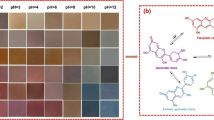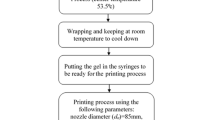Abstract
In this work, dynamic pH-sensitive quick response code (QR code) labels have been successfully fabricated by inkjet-printing technology. Inks with roselle anthocyanins and curcumin natural dye are prepared, respectively. The rheological property, contact angle, and surface tension of the prepared inks are tested. Both inks show good printability with Newtonian fluid property. The QR code labels with different ratios of inks are fabricated, in which the ink ratio is controlled by automatic computer program. It can be seen that the color of all printed QR code labels is sensitive to the concentrations of ammonia solutions, demonstrating that the pH-sensitive QR code labels are achieved. The ammonia-dependent color difference is analyzed by L*a*b* digital images. It can be found that the color difference strongly depends on the ink ratio, which suggests that the QR code labels with different ink ratios can be applied for diverse food freshness monitoring in real time. Therefore, in future, combined with the QR code application program (QR code APP) of intelligent devices, the developed QR code labels can be used as data carrier and freshness sensor as well, which provides a convenient method to get comprehensive food information, including freshness, expected storage time, date and identification of product, etc.
Graphical abstract








Similar content being viewed by others
References
He J, Yap RCC, Wong SY, Li X (2015) Polymer composites for intelligent food packaging. J Mol Eng Mater. https://doi.org/10.1142/s2251237315400055
Kalpana S, Priyadarshini SR, Leena MM, Moses JA, Anandharamakrishnan C (2019) Intelligent packaging: trends and applications in food systems. Trends Food Sci Technol 93:145–157. https://doi.org/10.1016/j.tifs.2019.09.008
Luo X, Lim L-T (2020) An inkjet-printed sulfonephthalein dye indicator array for volatile amine detection. J Food Sci 85(2):442–454. https://doi.org/10.1111/1750-3841.15020
Newsome R, Balestrini CG, Baum MD, Corby J, Fisher W, Goodburn K, Labuza TP, Prince G, Thesmar HS, Yiannas F (2014) Applications and perceptions of date labeling of food. Compr Rev Food Sci Food Saf 13(4):745–769. https://doi.org/10.1111/1541-4337.12086
Williams H, Wikstrom F, Otterbring T, Lofgren M, Gustafsson A (2012) Reasons for household food waste with special attention to packaging. J Clean Prod 24:141–148. https://doi.org/10.1016/j.jclepro.2011.11.044
Sharp JCM, Reilly WJ (1994) Recent trends in foodborne infections in Europe and North America. Br Food J 96(7):25–34. https://doi.org/10.1108/00070709410076333
Chen HZ, Zhang M, Bhandari B, Guo ZM (2018) Evaluation of the freshness of fresh-cut green bell pepper (Capsicum annuum var. grossum) using electronic nose. LWT-Food Sci Technol 87:77–84. https://doi.org/10.1016/j.lwt.2017.08.052
Qiao L, Tang XY, Dong J (2017) A feasibility quantification study of total volatile basic nitrogen (TVB-N) content in duck meat for freshness evaluation. Food Chem 237:1179–1185. https://doi.org/10.1016/j.foodchem.2017.06.031
Qiu WQ, Chen SS, Xie J, Qu YH, Song X (2016) Analysis of 10 nucleotides and related compounds in Litopenaeus vannamei during chilled storage by HPLC-DAD. LWT-Food Sci Technol 67:187–193. https://doi.org/10.1016/j.lwt.2015.11.047
Liu B, Xu H, Zhao HY, Liu W, Zhao LY, Li Y (2017) Preparation and characterization of intelligent starch/PVA films for simultaneous colorimetric indication and antimicrobial activity for food packaging applications. Carbohydr Polym 157:842–849. https://doi.org/10.1016/j.carbpol.2016.10.067
Huang SY, Xiong YB, Zou Y, Dong QF, Ding FY, Liu XH, Li HB (2019) A novel colorimetric indicator based on agar incorporated with Arnebia euchroma root extracts for monitoring fish freshness. Food Hydrocolloids 90:198–205. https://doi.org/10.1016/j.foodhyd.2018.12.009
Guo LL, Wang T, Wu ZH, Wang JW, Wang M, Cui ZQ, Ji SB, Cai JF, Xu CL, Chen XD (2020) Portable food-freshness prediction platform based on colorimetric barcode combinatorics and deep convolutional neural networks. Adv Mater 32(45):202004805. https://doi.org/10.1002/adma.202004805
Lee K, Baek S, Kim D, Seo J (2019) A freshness indicator for monitoring chicken-breast spoilage using a Tyvek (R) sheet and RGB color analysis. Food Packaging Shelf Life 19:40–46. https://doi.org/10.1016/j.fpsl.2018.11.016
Zhang JJ, Zou XB, Zhai XD, Huang XW, Jiang CP, Holmes M (2019) Preparation of an intelligent pH film based on biodegradable polymers and roselle anthocyanins for monitoring pork freshness. Food Chem 272:306–312. https://doi.org/10.1016/j.foodchem.2018.08.041
Wang J, Li DQ, Ye YX, Qiu Y, Liu JW, Huang L, Liang B, Chen BL (2021) A fluorescent metal-organic framework for food real-time visual monitoring. Adv Mater 33(15):2008020. https://doi.org/10.1002/adma.202008020
Nopwinyuwong A, Trevanich S, Suppakul P (2010) Development of a novel colorimetric indicator label for monitoring freshness of intermediate-moisture dessert spoilage. Talanta 81(3):1126–1132. https://doi.org/10.1016/j.talanta.2010.02.008
Lee GY, Shin HS (2016) Development of freshness indicator for quality of skate (Raja kenojei) during storage. Food Sci Biotechnol 25(5):1485–1489. https://doi.org/10.1007/s10068-016-0230-4
Lee GY, Lee S, Shin HS (2016) Evaluation of gas freshness indicator for determination of skate (Raja kenojei) quality during storage. Food Sci Biotechnol 25(5):1497–1500. https://doi.org/10.1007/s10068-016-0232-2
Kulchan R, Boonsupthip W, Jinkarn T, Suppakul P (2016) Developing a novel colorimetric indicator for monitoring rancidity reaction and estimating the accelerated shelf life of oxygen-sensitive dairy products. Int Food Res J 23(3):1092–1099
Loughran M, Diamond D (2000) Monitoring of volatile bases in fish sample headspace using an acidochromic dye. Food Chem 69(1):97–103. https://doi.org/10.1016/s0308-8146(99)00224-1
Bekhit A, Holman BWB, Giteru SG, Hopkins DL (2021) Total volatile basic nitrogen (TVB-N) and its role in meat spoilage: a review. Trends Food Sci Technol 109:280–302. https://doi.org/10.1016/j.tifs.2021.01.006
Ghaani M, Cozzolino CA, Castelli G, Farris S (2016) An overview of the intelligent packaging technologies in the food sector. Trends Food Sci Technol 51:1–11. https://doi.org/10.1016/j.tifs.2016.02.008
Ramalho JFCB, Correia SFH, Fu LS, Dias LMS, Adao P, Mateus P, Ferreira RAS, Andre PS (2020) Super modules-based active QR codes for smart trackability and IoT: a responsive-banknotes case study. NPJ Flex Electron 4(1):48–54. https://doi.org/10.1038/s41528-020-0073-1
Peng YQ, Zhang LX, Song ZX, Yan J, Li XX, Li ZB (2018) A QR code based tracing method for fresh pork quality in cold chain. J Food Process Eng 41(4):e12685. https://doi.org/10.1111/jfpe.12685
Qian JP, Xing B, Zhang BH, Yang H (2021) Optimizing QR code readability for curved agro-food packages using response surface methodology to improve mobile phone-based traceability. Food Packaging Shelf Life 28:100638. https://doi.org/10.1016/j.fpsl.2021.100638
Han S, Bae HJ, Kim J, Shin S, Choi SE, Lee SH, Kwon S, Park W (2012) Lithographically encoded polymer microtaggant using high-capacity and error-correctable QR code for anti-counterfeiting of drugs. Adv Mater 24(44):5924–5929. https://doi.org/10.1002/adma.201201486
Sun J, Shrestha K, Park H, Yadav P, Parajuli S, Lee S, Shrestha S, Koirala GR, Kim Y, Marotrao KA, Maskey BB, Olaoluwa OC, Park J, Jang H, Lim N, Jung Y, Cho G (2020) Bridging R2R printed wireless 1 bit-code generator with an electrophoretic QR code acting as WORM for NFC carrier enabled authentication label. Adv Mater Technol 5(2):1900935. https://doi.org/10.1002/admt.201900935
Kennedy ZC, Stephenson DE, Christ JF, Pope TR, Arey BW, Barrett CA, Warner MG (2017) Enhanced anti-counterfeiting measures for additive manufacturing: coupling lanthanide nanomaterial chemical signatures with blockchain technology. J Mater Chem C 5(37):9570–9578. https://doi.org/10.1039/c7tc03348f
Ramalho J, Correia SFH, Fu LS, Antonio LLF, Brites CDS, Andre PS, Ferreira RAS, Carlos LD (2019) Luminescence thermometry on the route of the mobile-based internet of things (IoT): how smart QR codes make it real. Adv Sci 6(19):1900950. https://doi.org/10.1002/advs.201900950
Burklund A, Saturley-Hall HK, Franchina FA, Hill JE, Zhang JXJ (2019) Printable QR code paper microfluidic colorimetric assay for screening volatile biomarkers. Biosens Bioelectron 128:97–103. https://doi.org/10.1016/j.bios.2018.12.026
Katoh A, Maejima K, Hiruta Y, Citterio D (2020) All-printed semiquantitative paper-based analytical devices relying on QR code array readout. Analyst 145(18):6071–6078. https://doi.org/10.1039/d0an00955e
Engel L, Benito-Altamirano I, Tarantik KR, Pannek C, Dold M, Prades JD, Wollenstein J (2021) Printed sensor labels for colorimetric detection of ammonia, formaldehyde and hydrogen sulfide from the ambient air. Sens Actuator B-Chem 330:129281. https://doi.org/10.1016/j.snb.2020.129281
Tarjan L, Senk I, Tegeltija S, Stankovski S, Ostojic G (2014) A readability analysis for QR code application in a traceability system. Comput Electron Agric 109:1–11. https://doi.org/10.1016/j.compag.2014.08.015
Abdolahi M, Jiang H, Kaminska B (2019) Structural colour QR codes for multichannel information storage with enhanced optical security and life expectancy. Nanotechnology 30(40):405301. https://doi.org/10.1088/1361-6528/ab2d3b
Kuswandi B, Jayus LTS, Abdullah A, Heng LY (2012) Real-time monitoring of shrimp spoilage using on-package sticker sensor based on natural dye of curcumin. Food Anal Meth 5(4):881–889. https://doi.org/10.1007/s12161-011-9326-x
Chen HZ, Zhang M, Bhandari B, Yang CH (2020) Novel pH-sensitive films containing curcumin and anthocyanins to monitor fish freshness. Food Hydrocolloids 100:105438. https://doi.org/10.1016/j.foodhyd.2019.105438
Zhang Y, Lim L-T (2016) Inkjet-printed CO2 colorimetric indicators. Talanta 161:105–113. https://doi.org/10.1016/j.talanta.2016.08.014
Grajeda-Iglesias C, Figueroa-Espinoza MC, Barouh N, Barea B, Fernandes A, de Freitas V, Salas E (2016) Isolation and characterization of anthocyanins from Hibiscus sabdariffa flowers. J Nat Prod 79(7):1709–1718. https://doi.org/10.1021/acs.jnatprod.5b00958
Esatbeyoglu T, Huebbe P, Ernst IMA, Chin D, Wagner AE, Rimbach G (2012) Curcuminu from molecule to biological function. Angew Chem-Int Edit 51(22):5308–5332. https://doi.org/10.1002/anie.201107724
Magdassi S (2010) The chemistry of inkjet inks. World Scientific Publishing Company, Singapore
Ohta N (1977) Correspondence between CIELAB and CIELUV color differences. Color Res Appl 2(4):178–182. https://doi.org/10.1002/col.5080020407
Chen HZ, Zhang M, Bhandari B, Yang CH (2019) Development of a novel colorimetric food package label for monitoring lean pork freshness. LWT-Food Sci Technol 99:43–49. https://doi.org/10.1016/j.lwt.2018.09.048
Giusti MM, Wrolstad RE (2003) Acylated anthocyanins from edible sources and their applications in food systems. Biochem Eng J 14(3):217–225. https://doi.org/10.1016/s1369-703x(02)00221-8
He Z, Xu M, Zeng M, Qin F, Chen J (2016) Interactions of milk alpha- and beta-casein with malvidin-3-O-glucoside and their effects on the stability of grape skin anthocyanin extracts. Food Chem 199:314–322. https://doi.org/10.1016/j.foodchem.2015.12.035
Khorasani MY, Langari H, Sany SBT, Rezayi M, Sahebkar A (2019) The role of curcumin and its derivatives in sensory applications. Mater Sci Eng C-Mater Biol Appl 103:109792. https://doi.org/10.1016/j.msec.2019.109792
Zheng DT, Huang CX, Huang HH, Zhao Y, Khan MRU, Zhao H, Huang LJ (2020) Antibacterial mechanism of curcumin: a review. Chem Biodivers 17(8):e2000171. https://doi.org/10.1002/cbdv.202000171
Ma QY, Du L, Wang LJ (2017) Tara gum/polyvinyl alcohol-based colorimetric NH3 indicator films incorporating curcumin for intelligent packaging. Sens Actuator B Chem 244:759–766. https://doi.org/10.1016/j.snb.2017.01.035
Acknowledgements
The authors gratefully appreciate financial support offered by the National Natural Science Foundation of China (Grant Nos. 51371129 and 11174226).
Author information
Authors and Affiliations
Corresponding authors
Ethics declarations
Conflict of interest
The authors declare that they have no conflicts of interest.
Additional information
Handling Editor: Maude Jimenez.
Publisher's Note
Springer Nature remains neutral with regard to jurisdictional claims in published maps and institutional affiliations.
Rights and permissions
About this article
Cite this article
Xu, Y., Liu, Z., Liu, R. et al. Inkjet-printed pH-sensitive QR code labels for real-time food freshness monitoring. J Mater Sci 56, 18453–18462 (2021). https://doi.org/10.1007/s10853-021-06477-x
Received:
Accepted:
Published:
Issue Date:
DOI: https://doi.org/10.1007/s10853-021-06477-x




